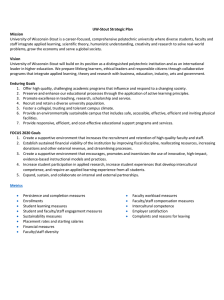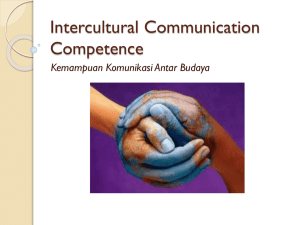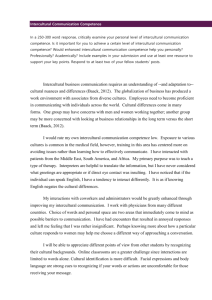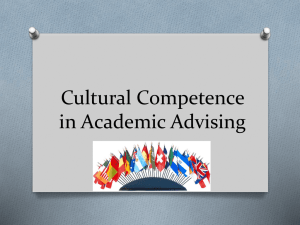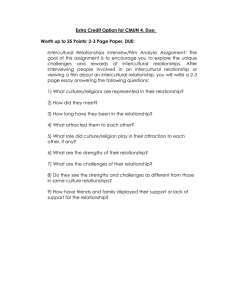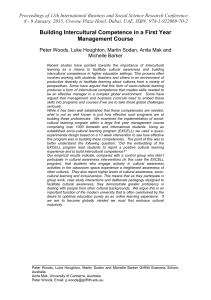CHAPTER 1 INTRODUCTION 1.1
advertisement
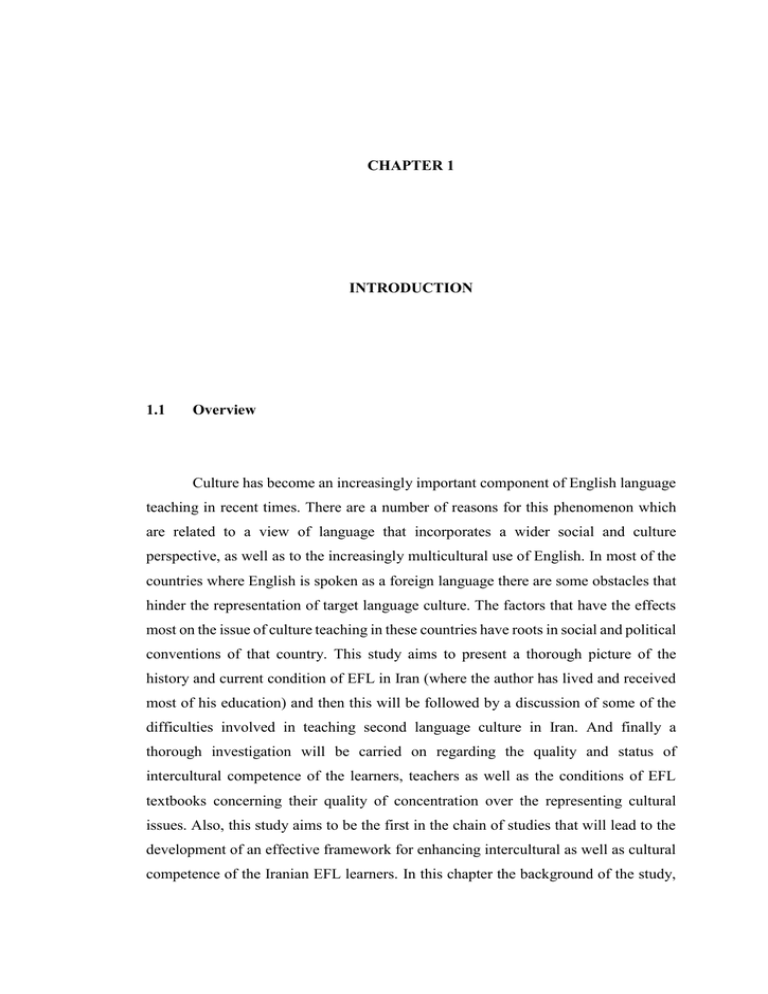
CHAPTER 1 INTRODUCTION 1.1 Overview Culture has become an increasingly important component of English language teaching in recent times. There are a number of reasons for this phenomenon which are related to a view of language that incorporates a wider social and culture perspective, as well as to the increasingly multicultural use of English. In most of the countries where English is spoken as a foreign language there are some obstacles that hinder the representation of target language culture. The factors that have the effects most on the issue of culture teaching in these countries have roots in social and political conventions of that country. This study aims to present a thorough picture of the history and current condition of EFL in Iran (where the author has lived and received most of his education) and then this will be followed by a discussion of some of the difficulties involved in teaching second language culture in Iran. And finally a thorough investigation will be carried on regarding the quality and status of intercultural competence of the learners, teachers as well as the conditions of EFL textbooks concerning their quality of concentration over the representing cultural issues. Also, this study aims to be the first in the chain of studies that will lead to the development of an effective framework for enhancing intercultural as well as cultural competence of the Iranian EFL learners. In this chapter the background of the study, 2 statement of the problem, objectives of the study, research questions as well as the significance and scope of the study will be discussed. 1.2 Background of the Study Generally it is believed that not only language is a part of culture, but also plays a very significant role in it. It is also believed that without the existence of language, the survival of culture would not be possible. Language concurrently reflects culture, and is shaped and influenced by it. In a more general sense, language is also the symbolic representation of a people, as it encompasses their cultural and historical backgrounds, as well as their approach to life and their ways of living and thinking. Brown (1994:165) describes the two as follows: “A language is a part of a culture and a culture is a part of a language; the two are intricately interwoven so that one cannot separate the two without losing the significance of either language or culture.” In short, culture and language are inseparable. As a result of this integration, mutual understanding and intercultural competence are more important than ever today because through them we can address some of the most dangerous problems of contemporary societies. There is a need for education which helps citizens to live together in culturally diverse societies. The ability to understand and communicate with each other across all kinds of cultural divisions is a fundamental prerequisite for making such societies work. We all need to acquire intercultural competence which according to Sercu (2010) is “conceived of as a general humanistic educational goal”. For this reason, intercultural education, which aims to develop and enhance this ability, can make an essential contribution to peaceful coexistence. Traditionally, the first attentions towards intercultural competence appeared out of investigations into the experiences of westerners working abroad in the 1950s, 3 1960s, and early 1970s. These studies were encouraged by apparent cross-cultural communication problems that hindered interactions between individuals from different backgrounds. According to Sinicrope, Norris, & Watanabe (2007), by the end of 1980s, the perspectives for intercultural competence studies expanded to include studying in a foreign country, worldwide business, cross-cultural training, emigrants living overseas, and immigrant acculturation. During the years, investigations on intercultural competence used assessments of individuals’ personalities, attitudes, motives and values, usually through surveys, short self-reports or open-ended interviews (Sinicrope, Norris, & Watanabe, 2007). The main aim and concentration of intercultural communicative competence assessment has been centered on four main goals: “(1) to explain overseas failure, (2) to predict overseas success, (3) to develop personnel selection strategies, and (4) to design, implement and test sojourner training and preparation methodologies” (Ruben, 1989: 230). Today, intercultural competence research encompasses a wide range, from medical training to international schools, from permanent residency in foreign cultures to short study abroad programs. The intentions for research also vary widely, from the selection of appropriate participants for sending abroad to cross-cultural mediation to the determination of learning outcomes associated with a variety of educational experiences. Mastering a foreign language involves enhancing various skills, including language proficiency, grammatical competence, communicative competence, as well as an alteration in the learners’ attitudes towards one’s own or another culture. For so many researchers, cultural competence which according to Thanasoulas (2001), is “the knowledge of the conventions, customs, beliefs, and systems of meaning of another country” is undeniably an essential aspectin foreign language learning, and many teachers have considered it as their objectives to include the teaching of culture into the foreign language class. It can be claimed that the concept of communicative competence which emphasizes the role of context and the circumstances under which language can be used accurately and appropriately, “fall short of the mark when it comes to actually equipping students with the cognitive skills they need in a secondculture environment” (Straub, 1999: 2). So it can be said that culture and communication are inseparable because as Thanasoulas (2001: 8) claims: “culture not only dictates who talks to whom, about what, and how the communication proceeds, 4 it also helps to determine how people encode messages, the meanings they have for messages, and the conditions and circumstances under which various messages may or may not be sent, noticed, or interpreted... Culture...is the foundation of communication.” In Iran, the context in which this study takes place, for many of the English language learners, learning cultural issues had been considered as merely background information in foreign language learning (Aliakbari, 2004). This attitude has influenced many aspects of the learners’ language learning concept including intercultural competence of students as well as design of the curriculum to be taught in language classes. Obviously this view contrasts the current situation that puts more emphasis and attributes great importance to culture learning and according to Sercu (2010) the aim of culture teaching has changed from prompting familiarity with the foreign culture. However there are issues that change and influence the notion of culture learning in language classes and affect it drastically and out of its natural trend. The change and emergence of cultural materials for Iranian learners is also associated with changes in social and political environment of the country as culture learning is part of that complex. EFL in Iran has experienced so many drastic ups and downs in recent years and social and political changes have contributed to this alteration a great deal (Aliakbari, 2004). English language education history in Iran can be split into two periods: before the Islamic Revolution of 1979 and after it. Before the revelation due to the close relationship of the Shah’s regime with western countries and specially United Sates, language schools were dominated by native-speaker instructors and the market was replete with authentic material, needless to say that the trend of target culture acquisition was headed toward a direction which was totally in contrast with what it is today, after the Islamic revolution (Bakhash, 1990). With the change in social and political norms, the educational system also changed and became a conservative, centralized educational system in which all decisions are taken by the authorities in charge in the government, and schools and teachers have to conform to the expected rules and regulations; in fact, there is no room for them to make their voices heard. 5 Educational institutions are considered to be the mere conveyers or performers of the governments' central policies. During this period, the EFL textbooks also have changed and the cultural elements underwent big changes and revisions. Since then no serious study investigated the culture teaching in Iranian national schools’ EFL textbooks, and this might be because authorities, learners and teachers thought they are on the right track and moving away from western culture is the proper decision. But about a decade ago Aliakbari (2004) investigated the state of culture in the Iranian high-schools’ EFL textbooks. The study revealed that the EFL textbooks which are currently used in Iranian national high schools are not helpful in developing intercultural competence and cultural understandings of students. Furthermore there is another crucial issue regarding integrating the cultural material in EFL classes and that is the role of both teachers and learners. Due to the undeniable nature of culture which is variable, controversial and different, the teaching of cultural items is very difficult and at the same time delicate job for most of the EFL teachers. According to Byram & Risager (1999), teachers can enhance the sense of openness in students. However an immense and confusing dilemma lies in front of the teachers. As Kramsch (2004) states, teachers need to find suitable methods for teaching culture, and yet they are obliged to look for ways of dealing with their society which imposes its own cultural beliefs and values. As the research shows in most of the contexts the lack of training for teachers is the root of the problem. The teachers should be trained and supported by their society because according to Dei, et al.(2000), these instructors bring alternative ways of knowing that can provide the students with greater points of access in developing broader worldviews. Learners’ role, in contrast seems to be lees important and contributing in the course of culture acquisition. In a common EFL class, students usually come from different cultural backgrounds and everyone has his own specific purpose of learning the language. For instance they may want to enter a high-ranking university or get a well-paid position in a company and they may not necessarily be interested to be culturally competent or have any desire to communicate crossculturally. The other issue that seems to be hindering the appropriate culture teaching 6 in some EFL classrooms is the vagueness and inconsistency between what different teachers believe is more culturally relevant to the students’ needs and this makes it hard to develop a curriculum for the cultural component of the class (Simpson 1997; Stern 1992). The main reason for this problem is that in many cases there is lack of cultural resources available for use in the classroom (Stern, 1992). Carr (1999) also claims that language teachers do not have ‘real tools for teaching culture’ and this is due to thelack of a practical model to understand the nature of culture and its relation to language. Therefore, this study aims to examine each of the above mentioned factors which are textbooks, teachers and students in the Iranian context regarding the level of appropriateness of intercultural competence. 1.3 Statement of the Problem The issue of Iranian learner’s cultural competence and inter-cultural competence has never been explicitly discussed. There is a serious absence of in-depth studies that investigate the intercultural competence of Iranian English Language learners. Although few studies have been done regarding this issue, however assumptions can be made based on the general beliefs of the teachers and inquiries from students, that exists a sort of be wilderness about the target languages culture among the learners and teachers (Majdzadeh, 2002; Saniei, 2012). While they feel, they should be aware of the culture of the language they are learning, Iranian learners have no idea how much and through what channels they should know and learn about the target culture. However, preliminary investigations reveal that most of the Iranian learners “have not acquired sufficient socio-pragmatic knowledge to be able to display the proper social behavior. That is, they are not sensitive to both social power and social distance” (Jalilifar, Hashemian, & Tabatabaee, 2011: 800). On the other hand there are different obstacles which hinder them from achieving this. Absence of cultural materials in texts books which is taught in national schools, lack of skills among teachers and government policies toward EFL can be mentioned as the most important issues that affect the notion of culture learning in the Iranian context. 7 Foreign language and especially English language teaching has experienced so many ups and downs. Before the Islamic Revolution in 1979, owing to the special relationship between the Iranian government and the west, particularly US and England, English language teaching received particular attention. Iranian learners were taking advantage of the presence of many native speaker teachers. The general condition led to such an extreme position that certain national universities were conventionally called American Universities (Aliakbari, 2004).The past revolutionary reactions to the EFL went to extremes as well. Due to the Islamic revolutionary oppositions against the US and the West as the main allies and supporters of the fallen king and because of the false notion of parallelism and association between the English language and the US, ESL went through fundamental and hostile changes. As results of a movement, which is known as “book purging”, the new educational authorities tried to de-culturise the national school and university English-teaching textbooks in the new materials designed, Iranian learners were exposed the concepts, topics and ideas that were culturally neutralized (Keddie, 2006). According to Cortazzi & Jin (1999), a textbook is potentially a teacher, a map, a resource, a trainer, an authority, a de-skiller and an ideology. A textbook can function as a teacher in a sense that it contains materials for the direct instruction of Englishspeaking countries culture. Although a textbook is designed to provoke learners and teachers, the textbooks, which are being used in Iranian national schools, act as a restrictor to the cultural awareness of the students because all these textbooks are designed, published and distributed under the supervision of the Ministry of Education. Also, this study aims to investigate the perception of learners’ and instructors’ towards their own interculturality as it provides an in-depth knowledge of the conditions of intercultural language learning in Iranian context as well as being the first of chain studies which will lead to developing an effective frame work for foreign language classes in through which more effective intercultural language teaching/learning will take place. 8 1.4 Objectives of the Study The objectives of this study are: 1. To determine the extent current Iranian EFL textbooks deal with intercultural understanding. 2. To determine the perceptions of Iranian learners which are indicative of intercultural competence. 3. To study the perceptions of Iranian EFL teachers which facilitate the development of intercultural competence in students. 1.5 Research Questions The study will attempt to answer the following questions: 1. To what extent do current Iranian EFL textbooks deal with intercultural understanding? 2. What are the perceptions of Iranian EFL learners which are indicative of intercultural competence? 3. What are the perceptions of Iranian EFL teachers which facilitate the development of intercultural competence in students? 9 1.6 Significance of the Study This study is significant because it seeks to enhance the learners’ intercultural competence. Considering the cultural dimension as a key aspect of language learning and teaching has been recognized as one of the most significant changes in the realm of ESL over the past few years. This change has affected the course of teaching and learning languages to a great extent. The objectives that students, teachers and even governments might pursue in language classrooms are no longer defined in terms of the acquisition of linguistic competence in a foreign language, which refers to a speaker's implicit, internalized knowledge of the rules of their language. It is widely accepted that one of the primary goals of foreign language learning is the ability to communicate and since communication in real situations never happens out of context and culture is a key ingredient of most contexts, culture-free communication is almost impossible to occur (Byram, 1989; Kramsch, 2004). In order to function appropriately, the learners need to acquire communicative competence as well. As a matter of fact communicative competence is a very general term. It can be divided into four aspects of grammatical, sociolinguistic, discourse, and strategic competencies (Canale & Swain, 1980). However another concept can be included in this list which is “Intercultural Competence”. In the field of language learning this notion is defined as “the ability of a person to behave adequately in a flexible manner when confronted with action, attitudes, and expectations of representatives of foreign cultures” (Meyer, 1991: 139). Learners are somehow able to achieve linguistic competence in the EFL situations where they have hardly any adequate and appropriate exposure to the target culture. Therefore, the EFL learners need to be made aware of cultural conventions and social norms of the target language in one way or another. Furthermore this study has a great significance to the society which is the focus of this research because the goal that many Iranian learners seek in language classrooms is to be able to communicate effectively with the representatives of other cultures and specifically English speaking cultures. 10 1.7 Scope of the Study The current study which is an investigation on cultural sensitive EFL material within the perspectives of English language materials design, involved examination of three most important components in the teaching/learning of target language culture: textbooks, teacher’s role and students’ role. The examination process was done by content analysis of EFL textbooks based on the models developed by Ramirez and Hall’s (1990) and (Cortazzi & Jin,1999). In addition, four lecturers and thirty students were selected for interview to examin and suggest the most proper role of the teachers and learners in the course of culture teaching/learning in EFL classes in order to enhance the intercultural competence of the learners. 1.8 Theoretical Framework This study in order to fulfill its objectives which is generally try to give a comprehensive picture of the quality and status of intercultural competence in Iranian EFL context, aims to examine and detect the existence and quality of the dimensions of intercultural competence which are specified through the search of the literature. Also the nature of these dimensions is supported by a number of theories and comprehensive models developed by experts. As Figure 1.1 reveals each of the building dimensions of intercultural competence is specified through the search of literature. These dimensions include: 1. Orientation to knowledge and 2. Empathy, identified by Ruben (1976) 3. Respect for otherness, 4. Knowledge discovery and 5.Attitude identified by Byram (1997) and 6. Cultural affinity identified by Kupka, Everett, & Wildermuth (2007). This study has justified and supported the relevance and contribution of the mentioned dimensions to the notion of intercultural competence by using a number of theories including: Theory 11 of linguistic relativity, theory of intercultural language learning, anxiety and uncertainty management theory, cultural identity theory and identity management theory. Also this study has analyzed the textbooks used in Iranian context using the model developed by Cortazzi and Jin (1999). Theory of linguistic relativity justifies and explains “orientation to knowledge” which is one of the most important dimensions of intercultural competence and is defined by Ruben (1976: 337) as “an individual’s ability to recognize the extent to which knowledge is individual in nature” or it is explained in the literature review it is a person’s capability to identify and recognize that each individual explains the world in different ways. Empathy, respect for otherness and knowledge of discovery are other dimensions of intercultural competence which are justified and explained through theory of intercultural language learning. According to Ruben (1976: 337) who identified empathy as one of the dimension of intercultural competence, it is “an individual’s ability to put [himself] in another’s shoes.” as it is explained in Chapter 2 knowledge of discovery which is explained by Byram (2007: 6) as “the ability to acquire new knowledge of a culture and cultural practices and the ability to act using that knowledge, those attitudes and those skills under the constraints of real-time communication and interaction”, is another dimension of intercultural competence. The last dimension which supported by theory of intercultural language learning is respect for otherness identified by Byram (1997: 7) as “the readiness to suspend disbelief about other cultures and belief about one’s own”. As explained in details in Chapter 2, another dimension of intercultural competence according to Byram (1997: 91) is identity formation or attitude which is “the ability to relativize one’s self and value others, and includes curiosity and openness, readiness to suspend disbelief about other cultures and belief about one’s own”. This dimension of intercultural competence is justified and supported by cultural identity theory and identity management theory which are discussed in more 12 details in review of the literature. And finally, “intercultural affinity” which is identified by Kupka, Everett, & Wildermuth (2007) is another dimension of intercultural competence. Intercultural affinity is inferred as an emotional disposition towards one’s home culture as well as one or more foreign cultures. This dimension of intercultural competence is supported by theory of anxiety and uncertainty management. The theoretical framework of this study also suggest that the model used for the evaluation of textbooks is the one suggested by Cortazzi and Jin (1999). As it is explained in literature review the representation of target culture in ELT textbooks is done through including specific names, geographical names of target context and such. Therefore the current study using the features of an ideal textbook for presenting cultural elements which is depicted in the model of Cortazzi and Jin, has evaluated the condition and quality of cultural features in Iranian ELT textbooks. 13 Learners Model of Cortazzi and Jin Intercultural Competence Textbooks Orientati on to knowledg e Theory of Linguistic Relativity Empathy Teachers Knowledg e of Discovery Theory of Intercultural Language Learning Respect for Othernes s Cultural Affinity Anxiety and Uncertainty Management Theory Figure 1.1: Theoretical framework Attitude Cultural Identity Theory & Identity Management Theory 14 1.9 Limitations of the study This study has some limitations regarding the analysis of one particular educational context with a self-selected population. Although results are not generalizable to every educational environment, they are a valuable addition to knowledge in this area. There were limitations in the sample size, the number of students and teachers (no gender balance: all participants are male) interviewed, the short time span over which observations and data collection were done, and the design of the focus group questions. Also due to the nature of the research and instruments used for data collection, the presence of the researcher during the data collection period was beneficial, however because the researcher was not present in the context in which the study has been carried out, the interview sessions was audio-taped. Also there is another limitations concerning the reliability of the instruments. The group interview questions as well as the teacher interview questions were adapted from the study by Moloney (2007) and the necessary changes have been made in order to fit the context in which the study was carried out. Then the answers were analyzed using the coding system developed in the same study for the same purpose. Therefore one of the limitations of this study is the estimation of inter-rater or inter-observer reliability for the coding scheme and thematic codes developed for the analysis of students’ and teachers’ interviews is not performed. 15 1.10 Definition of Terminology 1.10.1 Second/Foreign Language A second language or L2 is any language learned after the first language or mother tongue. In pedagogy, a distinction is often made between 'second language' and foreign language, the latter being learned for use in an area where that language is not generally spoken. Arguably, English in countries such as India, Pakistan, Bangladesh, the Scandinavian countries and the Netherlands can be considered a second language for many of its speakers, because they learn it young, speak it fluently, and use it regularly. However, throughout this study the term Foreign Language is used since the context in which the study takes place the English is considered to be a foreign language as the environment of class is the only place that the language can be spoken. 1.10.2 Intercultural Competence Intercultural competence is the ability to work successfully within and across various cultures. According to theorists, “The components of intercultural competence are knowledge, skills, and attitudes, complemented by the values one holds because of one’s belonging to a number of social groups, values which are part of one’s belonging to a given society (Byrum, Nichols, and Stevens, 2001).” In this study however Iranian learners will be examined based on the criteria which make intercultural competent learner. 16 1.10.4 EFL/ESL Learners An ESL learner lives in a country where English is the dominant language. The students could be immigrants or visitors. The students in ESL class are usually of mixed nationalities, consequently most of the times students don’t share a common language or a common culture. Outside the classroom, students have a specific and practical need for English, and plenty of opportunities to use the language. However, an EFL learner resides in a country where English is not the dominant language. Students share the same language and culture. Outside of the classroom students have very few opportunities to use English. For some of the students learning English may not have any obvious practical benefit. Students have limited exposure to English-speaking culture, most often through a biased lens like TV or music. In the current study EFL learners refers to Iranian young adults who are at the pre-university level of government schools. They only attend national schools. 1.10.5 ELT Textbooks English language instruction has many important components but the essential constituents to most of the ESL/EFL classrooms and programs are the textbooks and instruction materials that are often used by language instructors. According to Hutchinson and Torres (1994: 315) suggest: "The textbook is an almost universal element of English language teaching. Millions of copiesare sold every year, and numerous aid projects have been set up to produce them in various countries and no teaching-learning situations complete until it has 17 its relevant textbook”. In this study, textbooks being used in different contexts are referred to as ELT materials. In Iranian context learners have access to various textbooks, however they can be categorized into two different groups: those that are published under the supervision of Iran’s Ministry of Education, and the ones which are considered to be authentic textbooks and are published mostly in the United States and the Great Britain are used as mostly none authorized prints in private language schools. 1.11 Summary The chapter provides an overall view of the study. The connection between the subjects discussed is provided and the gap and the problem which this study deals with is presented. From the topics discussed, it is hoped that readers can gain useful insight on what to expect and obtain from this research.
